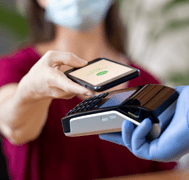 Contactless payment methods have existed for many years for businesses in all sorts of industries.
Contactless payment methods have existed for many years for businesses in all sorts of industries.
People can pay with their debit and credit cards, by scanning QR codes, paying via mobile wallets such as Apple Pay and Android Pay, paying via store apps, or more.
With the rise of COVID-19 over the last year, contactless payments have been especially popular as the preferred method of payment as businesses and consumers look for ways to minimize physical interaction as much as possible.
According to Forbes, contactless payment systems have been on the rise since the pandemic started. In fact, 54% of consumers stated they would switch to retailers that provide contactless payments.
However, good contactless payment methods can’t just solve the health and safety concern of consumers, security risks must also be considered.
With Technology, There’s Always a Risk
With convenience comes risks. Like any technology that exists, contactless payments can have mobile security and data privacy risks.
Firstly, there’s no pin required when using contactless payments in-store. Anyone can easily make payments using someone else’s bank card. How can retailers verify customer identity to ensure the bank card belongs to them?
While mobile wallets use near-field communication to transmit data, contactless credit cards use RFID to transmit data from the scanner to the internal payment system. There’s a chance for hackers to create cloned cards with the information from the credit card.
Contactless systems also create data risks because they collect large amounts of data from customers. This information can be used to track customers or can be hacked into and stolen.
Lastly, anytime a mobile app is downloaded, there is always a risk of malware and phishing scams designed to steal sensitive data such as bank account numbers and personal information.
Adding Security Decreases Risks
Organizations need to reduce possible security risks as much as they can for contactless payments.
Adding a multifactor authentication to the transaction can increase the security of each payment. A password, digital signature, or another form of identification can ensure payers are verified and decrease the chance of fraud.
Making sure all transactions are encrypted allows data and sensitive information to be transmitted and stored securely.
Using device-centric cryptography verifies the payment information is coming from a single device and prevents hackers from stealing customer information.
Lastly, following Payment Card Industry (PCI) Security Standards Council guidelines for payment and privacy allows for a safer payment experience for all customers.
At SHEA Global, we can help retailers conduct assessments of the contactless payment methods offered. Our solutions focus on technologies such as cloud computing to ensure payment transactions and data are securely used and stored. Reach out today for a consultation!